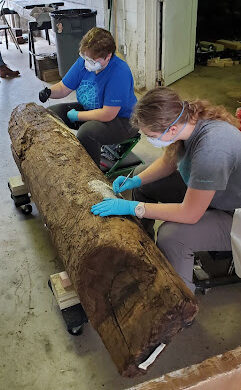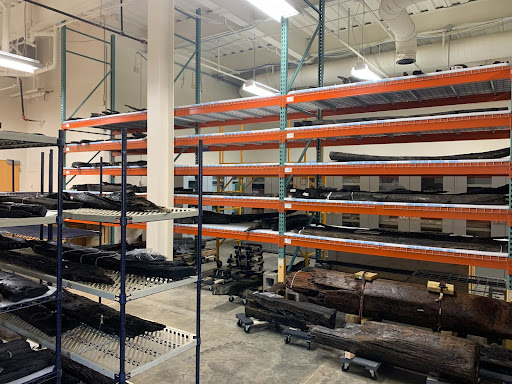Hiya, it’s Jules and Ariel again with a Princess Carolina exclusive. You can learn so much more about the ship and our project by reading our previous blog Princess (Carolina) Protection Program, but we’re back today to give you a close up of the journey of one timber in particular: the mizzenmast.

For a quick review, Princess Carolina is an 18th-century merchant ship whose timbers are now being documented, cleaned, and rehoused as part of our Bronze Door Society conservation internship at The Mariners’ Museum and Park. Some of these timbers were crafted from strong woods like elm and white pine (Riess 2023), however many were also made from live oak, one of the heaviest hardwoods in North America (Riess and Smith 2015). As we make our way through the hundreds of timbers there are some that are so large and so heavy that they can’t be moved with hands alone.

Enter the engine hoist. This hoist has both wheels and retractable arms and legs, which is perfect for working around timbers of odd shapes and sizes. We want to walk you through how we safely handle some of these larger timbers, and what better example than a fragment of Princess Carolina’s mizzenmast.
But wait. What even is a mizzenmast? How is it different from other masts? Great questions – let’s talk about it!

A mast’s job is to support the vessels’ sails. There are three main types of masts: foremast, mainmast, and mizzenmast. The foremast, and all of its associated sails and ropes, is located closest to the bow of the ship, while the mainmast is closer to the center of the vessel. Finally, the mizzenmast is the mast that is aft (behind, near the stern of the ship) the mainmast (Steffy 1994).
Princess Carolina had all three types of masts, and potentially an additional foremast according to archaeologist Warren Reiss that was jury rigged, meaning constructed very quickly and likely for emergency purposes (Reiss 2023).

Unlike many of the larger timbers, the mizzenmast was constructed from white pine rather than live oak. This fragment of the mizzenmast was the only mast recovered during the 1982 excavations, likely because the mainmast and foremast(s) were removed prior to the ship’s sinking to be reused (Reiss 2023).
So how do we move this puppy? It’s a process, and we want to adhere to best practices, so our main goal is to protect the object and the Conservation team during any necessary handling. Luckily, the majority of the Conservation team is certified for crane and rigging operation as well as forklift use. Over the years, they have gained a lot of experience with large artifacts moves notably from the USS Monitor Collection which is very helpful for this project! As mentioned above, an engine hoist was first necessary to lift the mast from its original resting spot onto the dollies and make it easier to handle during photographing and cleaning.
Once it was clean, labeled, and ready for transport, we used rigging straps and a large gantry crane to lift it onto the trailer.

Once we got the trailer out to the freezer, we used our last piece of heavy machinery: the forklift.
The forklift’s arms were slid into the straps still attached to the timber and it was slowly carried to the door of the walk-in freezer. Right inside the freezer, the mizzenmast was placed onto two dollies with blocks and wedges to keep the timber off the floor and to maintain some mobility.


It was a long process that involved a lot of equipment, time, and hands, but at the end of the day, the mizzenmast was in the freezer, just chilling.
A week later, we woke the mast (and all the other timbers in the freezer) from their cold slumber and broke out the machinery again to move everything out of the freezer and into the Batten Conservation Complex workroom.


The mizzenmast, along with the rest of Princess Carolina’s timbers, will defrost in the workroom and eventually be organized onto large shelves, inventoried, and await future research and treatments.

Thanks for coming along! Keep an eye out for more conservation updates, and check out some of the previous blogs about Princess Carolina and treatment of the timbers on The Mariners’ website!
References:
Reiss, Warren. Studying the Princess Carolina: the anatomy of the ship that held up Wall Street.
College Station: Texas A&M University Press, 2023.
Reiss, Warren and Sheli Smith. The Ship that Held Up Wall Street: the Ronson Shipwreck.
College Station: Texas A&M University Press, 2015.
Steffy, J. Richard. Wooden Ship Building and the Interpretation of Shipwrecks. College Station: Texas A&M University Press, 1994.